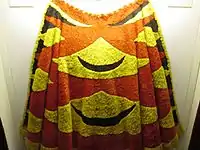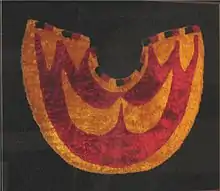Feather cloak
Feather cloaks have been used by several cultures.

%252C_Nahiennaena_(1825).jpg.webp)

Hawaii
Elaborate feather cloaks called ʻahuʻula[1] were created by early Hawaiians for the aliʻi (royalty).[2] Feathers were also used in women's skirts called pāʻū.[3] The ʻiʻiwi (Vestiaria coccinea) and ʻapapane (Himatione sanguinea), which provided red feathers, were killed and skinned due to their abundance. Yellow feathers were obtained from the mostly black and rarer ʻōʻō (Moho nobilis) and mamo (Drepanis pacifica) using a catch and release philosophy to ensure future availability.[4]
Māori
In Māori culture feathers are a sign of chiefly rank,[5] and the kahu huruhuru (feather cloak),[6] is still used as sign of rank or respect.[7][8]
Irish
The elite class of poets known as the filid wore a feathered cloak, the tuigen.
Norse
In Norse mythology, the goddess Freyja owns a feather cloak called "feather-skin" fjaðrhamr[lower-alpha 1][9][10] and also referred to as a "falcon-feathered cloak" (Old Norse: valshamr).[lower-alpha 2].[11][10]
There is also the pair of wings fashioned for Wayland Smith to help his escape, depicted on a panel of the 8th century ivory Franks Casket,[12] and the corresponding episode is preserved in the Þiðreks saga.[12] Though the flying apparatus is called "wings" or "a wing" (ON Old Norse: flygil), borrowed from the German Flügel,[13] the finished product is said to be very much like a fjaðrhamr (feather-skin) flayed from a griffin, or vulture, or an ostrich (Old Norse: "fleginn af grip eða af gambr eða af þeim fugl er struz heitir").[14][15][16][lower-alpha 3][lower-alpha 4]
There are bird-people depicted on the Oseberg tapestry fragments, which may be some personage or deity wearing winged cloaks, but it is difficult to identify the figures or even ascertain gender.[17]
Famous works
- Nāhiʻenaʻena's Paʻū, feather skirt of Princess Nāhiʻenaʻena and funeral garment of Hawaiian royals[18][19]
- Kamehameha's Cloak, feather cloak of Kamehameha I made entirely of the golden-yellow feather of the mamo, used by the kings of Hawaii
- Kiwalao's Cloak, feather cloak of Kīwalaʻō captured by Kamehameha I in 1782, used by the Queens of Hawaii
- Liloa's Kāʻei, sash of King Liloa of the island of Hawaii
Explanatory notes
- In the poem Þrymskviða 3,6; 5,2; 9,2.
- In the Prose Edda
- The terms grip and gambr (gammr) are both glossed as 'vulture' in Cleasby-Vigfusson and Haymes's translation collapses three birds into two: "winged haunch of a vulture, or of a bird called ostrich". The sense of 'vulture' (prob. for grip) is suggeted by Schröder.[14]
- The fjaðrhamr has also been rendered as "feather haunch" or "winged haunch",[15] even though the literal translation would be "feather skin".[10]
References
- Mary Kawena Pukui and Elbert (2003). "lookup of ahu". on Hawaiian dictionary. Ulukau, the Hawaiian Electronic Library, University of Hawaii. Archived from the original on 2012-07-18. Retrieved 2010-04-04.
- "Na Hulu AliʻI: Royal Feathers ~ An Exhibition Of Rare Hawaiian Featherwork". Hawaii Visitors & Convention Bureau. September 2, 2006. Archived from the original on May 23, 2011. Retrieved 2009-11-29.
- Mary Kawena Pukui and Elbert (2003). "lookup of pā.ʻū". on Hawaiian dictionary. Ulukau, the Hawaiian Electronic Library, University of Hawaii. Archived from the original on 2012-07-16. Retrieved 2010-04-04.
- Hiroa, Te Rangi (1944). "The Local Evolution of Hawaiian Feather Capes and Cloaks". The Journal of the Polynesian Society. 53 (1): 1–16.
- Te Ara
- Te Ara
- "Elton John gifted rare Maori cloak". The New Zealand Herald. December 7, 2007. Retrieved September 30, 2011.
- Kay, Martin (9 April 2009). "Clark gets cloak for a queen". The Dominion Post. Retrieved 30 September 2011.
- McKinnel, John (2014). "8 Myth as Therapy: The Function of Þrymskviða". In Kick, Donata; Shafer, John D. (eds.). Essays on Eddic Poetry. University of Toronto Press. p. 201. ISBN 9781442615885.
- Cleasby & Vigfusson (1974), An Icelandic-English Dictionary, s.v. "hamr".
- Byock, Jesse (2005). "Introduction". The Prose Edda. Penguin UK. p. xxii. ISBN 9780141912745.
- Vandersall, Amy L. (1972). "The Date and Provenance of the Franks Casket". Gesta. 11 (2): 12–13-. JSTOR 766591.
- Cleasby & Vigfusson (1974), An Icelandic-English Dictionary, s.v. "flygil".
- Shröder, Franz Rolf (1977) "Der Name Wieland", BzN, new ser. 4:53–62. Quoted by: Harris, Joseph (2005) [1985]. Clover, Carol J.; Lindow, John (eds.). Eddic Poetry. Old Norse-Icelandic Literature: A Critical Guide. University of Toronto Press. p. 103. ISBN 9780802038234.
- Þiðreks saga Ch. 77, Haymes, Edward R., tr. (1988). The Saga of Thidrek of Bern. Garland. pp. 53–54. ISBN 0-8240-8489-6.
- Þiðreks saga Ch. 77, Unger, Henrik, ed. (1853). Saga Điðriks konungs af Bern: Fortælling om Kong Thidrik af Bern og hans kæmper, i norsk bearbeidelse fra det trettende aarhundrede efter tydske kilder. Christiania: Feilberg & Landmark. pp. 92–94.
- Mannering, Ulla (2016). Iconic Costumes: Scandinavian Late Iron Age Costume Iconography. Oxbow Books. p. 6-27. ISBN 9781785702181.
- Ron Staton (June 9, 2003). "Historic feather garment to be displayed". The Honolulu Advertiser.
- Burl Burlingame (May 6, 2003). "Rare pa'u pageantry The grand cloak is made of hundreds of thousands of feathers from the 'oo and mamo birds". Honolulu Star-Bulletin. Retrieved 2001-11-29.
The Saga of Thidrek of Bern. Translated by Edward R. Haymes. New York: Garland, 1988. ISBN 0-8240-8489-6.